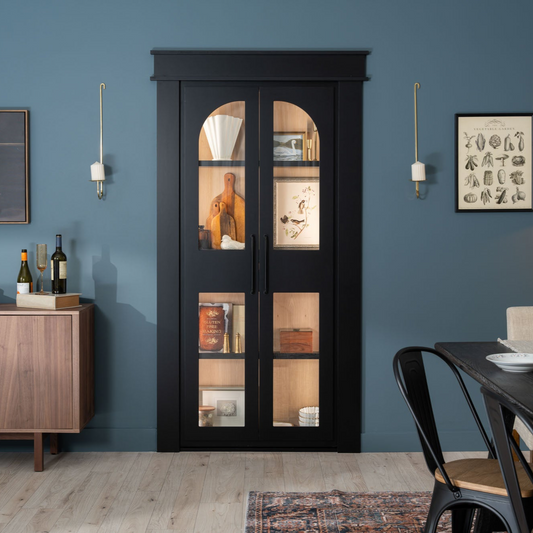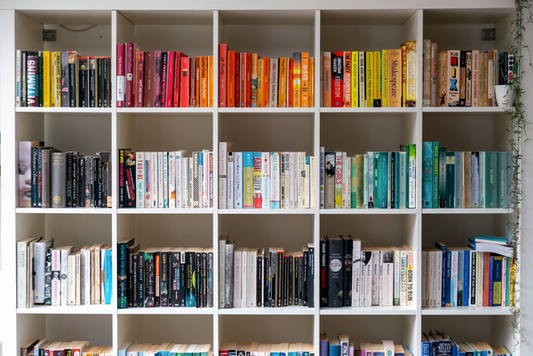The obvious purpose of a hidden door is for security — to conceal a safe room or valuables. But as pre-built, ready-to-install doors become more widely available, people are adding them for aesthetics, for fun or maybe because they watched too much “Scooby-Doo.”
For D.C. resident Nicole Buell, a bookcase that concealed a doorway solved a design problem. In her 540-square-foot Columbia Heights condo, the doors to the only bathroom were in her bedroom and the living area. The living area door left too little room for pictures or bookcases. “It just wasn’t a good use of space,” Buell said. Walling over the door was an option, “but,” she said, “I didn’t want guests to have to go through the bedroom to get to the bathroom.”
The solution began with door hinges bought from Secret Doorways, a company in Sunbury, Ohio, owned by a cousin. With the help of her father, she constructed shelves and mounted them on the ball bearing hinges to create a bookcase that swings open to reveal the loo. “It’s fun to surprise my guests when they visit,” she said.
Now secret doors are going mainstream. “It has become more of a trend than we expected,” said Jeff Watchko, the interior door buyer for Home Depot.
Three years ago, Home Depot began to offer, online, pre-hung bookcase-doors from Murphy Door in Ogden, Utah. “The overall draw to the site was more than we expected,” Watchko said. “It’s very popular on the East Coast and anywhere there is a large metropolitan area.”
The Murphy doors can come pre-hung — already mounted in a frame — in standard door sizes, so it’s a simple matter to install one in a doorway.
Watchko said the popularity of the secret doors — which range from $850 to $1,750, depending on size and finish — has prompted Home Depot to introduce displays of them in several cities. “We are looking at rolling out a pilot program in select stores,” he said. “It will be the first time people can walk into a store and touch and feel a Murphy door.”


Julie Patrick of Alexandria added a Murphy door to the condominium unit she purchased in the Del Ray neighborhood almost a year ago. The building was constructed in 1939, and her unit had closets so small that “you had to turn jackets in sideways to get them in,” she said.
But a tiny hallway closet backed up to her bedroom closet. Opening the wall between the two gave her a closet big enough that “in a pinch,” she could dress in it. She could have closed off the hallway closet entrance, but after seeing bookcase-doors on Pinterest, “I realized this is something people do. I could do this,” she said. “It was really just for the coolness factor that I did it.”
She didn’t purchase through Home Depot, she said, because her closet door was not a standard size. “I realized what I needed required a special order,” she said. “The range they can do in their customization is amazing.”
She was sent wood samples to choose from. Customer service helped with design — whether to get shelves or shelves and cabinets (she went with just shelves). When the completed door arrived, “the hardest thing was to take it off the pallet,” she said. “It was ready to go in.”
The result is a 24-inch bookcase-door. “It’s small,” she said, “so you have to think skinny thoughts to get through.”
Leigha Basini of Lorton, Va., decided to save on a Murphy door by purchasing it in a kit, which arrived ready for her contractor to construct. Kit doors save $200 on assembly and $125 on shipping, said Jeremy Barker, chief executive of Murphy Door.
“We were redoing our master bathroom and closet, and I don’t know where I saw hidden doors, but I was a big mystery reader as a child, and when I saw we could have a hidden door, I wanted one,” Basini said. “It was probably three-quarters fun, one-quarter storage.”
Basini’s contractor assembled and installed the door while she was at work. “I was shocked, because I just came home and there it was,” she said. The shelves on the bathroom side swing open to reveal a walk-in closet. “That is exactly what I wanted. It brought me back to my childhood, wanting a secret room, and I loved it,” she said.
The shelves hold nonbreakables, such as tissue and cotton balls. Items that might roll off are in baskets, and Basini also bought some putty to secure items as required. “I haven’t needed it,” she said of the putty. “I just have to remember not to push the door open too forcefully.”
She has shown the passageway only to select friends. It is, after all, in the master bath. “Everyone said they think it’s unique,” she said, “but I don’t know if anyone would tell me to my face that it’s stupid.”
The effect of a hidden door on the value of a house is debatable. Manufacturers say hidden doors increase market value. But Victor Brown, a real estate agent and a home appraiser with Capital Market Appraisal in the District, said that is unlikely. “My initial reaction is, no, it wouldn’t raise value,” he said. “It isn’t a big enough item.” Location, size, condition and exterior amenities are far more important, he said.
But Brown said that mentioning a hidden door in ads might attract more traffic to an open house. “Indirectly, it might help you get a higher value because you are getting more people interested, which might drive the price up,” he said. “The key word there is might.”
There are people who want something more elaborate than a swinging bookcase. For them, there are companies such as Creative Home Engineering in Gilbert, Ariz. Founded by Steven Humble, who said he began his career as a machine engineer at Boeing, Creative Home often designs doors of unusual size and complexity. The options include a mirror that hides a safe room and an entry large enough to drive a vehicle through.
Because the doors are on the pricier side — a mirror panel starts at $1,500 — a smaller proportion of Humble’s customers are buying for aesthetics alone. “I’m going to say 75 to 80 percent have a security purpose in mind,” he said.
Michael W. Trott, a security consultant for high-net-worth clients, and a repeat client of Humble’s, said there are two parts to panic room security: the “hardening” of the room — to withstand an assault and to secure food, water and air long enough for help to arrive — and the camouflage factor.
“If they don’t even know you are hidden somewhere,” Trott said, “you reduce your chances of getting caught.” He said he chose Humble’s company because the camouflage is especially good and because the doors can be “hardened” to withstand an attack.
Although camouflage is security enough for some clients — “Who is going to attack a full-length mirror?” Humble asked — others want bulletproof, bomb-resistant enclosures. “It looks like wood or brick, but basically it’s armored steel and weighs north of 1,000 pounds,” he said.
Humble said his most elaborate hidden door was a closure at the top of a spiral staircase that ran between a guest area below and living quarters above. The door operated like the adjustable aperture, or iris, of a camera lens. The iris, made of bronze, was bulletproof, motorized and weighed more than 2,000 pounds, he said.
“The project turned out amazing,” Humble said, “but the cost ended up being close to $200,000.”
Because many of his clients work in highly sensitive positions in government and business, Humble declined to describe specific panic rooms and other products his company has installed in their homes.
He did, however, discuss a job his company did for the Jefferson, a luxury hotel in downtown Washington. In Room 410, a massive mirror swings away to reveal a hidden closet.
“We were reorganizing the closet, then we thought, ‘Wouldn’t it be cool to have a secret door mirror?’ ” said Daren Rubenstein, the Jefferson’s director of engineering.
Rubenstein said he researched hidden doors online and, deciding against a do-it-yourself variety, hired Creative Home Engineering because of the fit-and-finish requirements of the product. “If you didn’t know there was secret door in the room, it would take quite a while to figure it out,” he said.
In fact, the year-old novelty installation has been a bit of a problem for that very reason. The staff doesn’t always remember to alert guests to the door’s existence. “A lot of times, the guest can’t find the closet,” Rubenstein said, which leads to a call to the front desk. “When they find it,” he said, “they love it.”
The Jefferson has another, older hidden door that was installed during renovations in 2007. The door is between the kitchen and a private dining room. Used for James Bond-themed parties, the door allowed a manager dressed as arch villain Ernst Blofeld to slip into the room surreptitiously. But if Blofeld’s plans for world domination hinged today on his entering by that hidden door, he would be thwarted once again. The door is blocked on the kitchen side by a baker’s rack.



